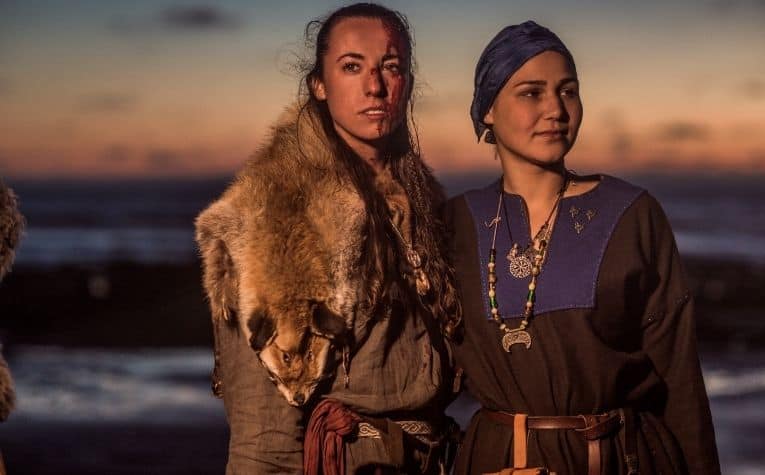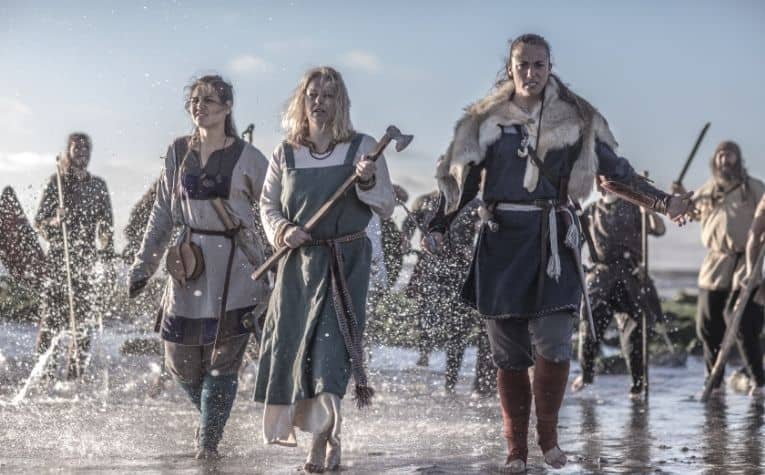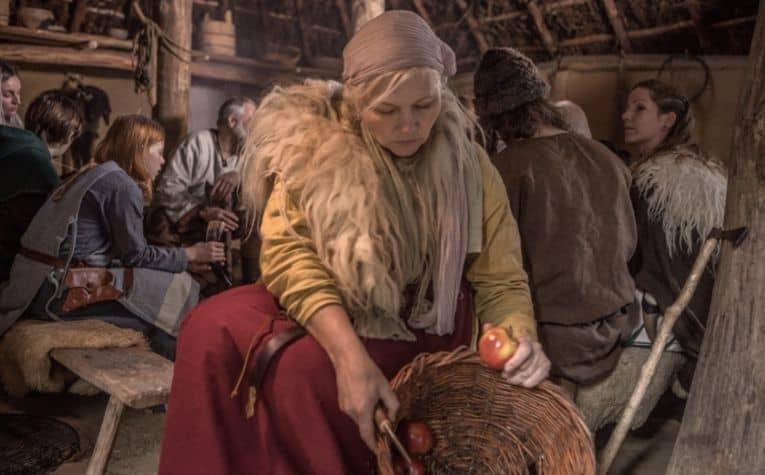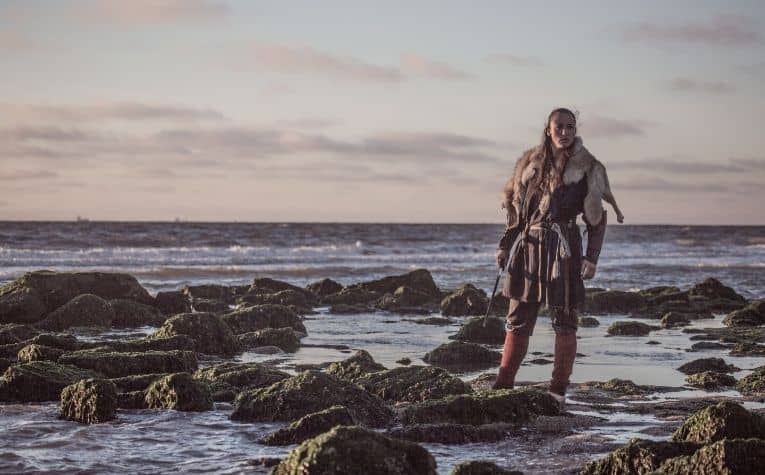Much of what is known about the Norse people and the lives they led during the Viking Age has been pieced together through fragmented pictures provided by oral tradition, various writings (which were written many years after the fact), and archaeological finds.
One of the hottest topics of debate is whether female Vikings took part in the violent raids that besieged Northern Europe for centuries.
While there are scholars who believe that there were female Vikings that went on raids and others who strongly dispute such assertions, Norse society seemingly embraced the notion of female warriors.
This is perhaps best exemplified by legends of shield maidens and myths involving the Valkyries.
Whether or not female Vikings directly participated in raids is a matter that will continue to be debated until conclusive evidence surfaces that puts the question to rest.
However, what seems beyond dispute is that Norse women, and even children, were part of raiding parties that spent long periods abroad, with many eventually settling in new lands.

Support for the Notion of Female Viking Raiders
Norse sagas and poems contain detailed accounts of the exploits of Viking warriors on the fields of battle.
Heroic female warriors are also featured in Scandinavian and Danish tales, brandishing swords, and holding their own alongside male Vikings.
But to prove the existence of female Viking raiders, proponents point to actual archaeological finds.
In the eyes of many, archaeological and scientific evidence supports the notion that female Viking warriors fought alongside their male counterparts and were highly respected in life and celebrated in death.
They were even honored with burials previously thought to be reserved exclusively for distinguished Viking warrior men.
Separation fact from fiction. See The Truth About Viking Women: 15 Facts to learn more.
Female Viking Burial Sites Suggest That They Raided

During the 19th century, archaeologists dug at an old Viking settlement known as Birka, located in Sweden.
They uncovered roughly 1,100 graves, most of which were relatively nondescript, indicating that the buried were ordinary citizens.
There were two, however, that included full sets of weaponry and military gear indicating that the buried were prominent Viking warriors.
One of the two graves contained such a wide assortment of armor-piercing arrows that researchers theorized that the buried person was an archery specialist, likely on horseback as there were two horses buried in the same grave.
Also among the grave contents were articles of clothing indicating a high-ranking military officer and a gaming set (to sharpen strategist skills) found only in warriors’ graves.
In 2017, scientists released a genetic analysis revealing that the warrior in question was, in fact, female.
The same team reaffirmed this controversial and highly criticized finding in 2019.
What was the fate of Viking women? See Did Female Vikings Go to Valhalla? to learn more.
As far as the person’s prominence in life, the burial site was marked by a highly visible grave marker, indicating that the female Viking warrior buried there was indeed an esteemed member of her community. [1] [2]
Further supporting the belief that female Viking warriors existed was another burial site discovered in Solor, Norway, in 1900.
Like the Birka warrior, the Solor Viking was buried with military hardware, including a sword, spear, and battle ax, and was also determined to be female.
In fact, the remains showed a non-fatal battle wound suffered to the head, likely the result of a blow with a sword or ax. [3]
Viking Scholars Dispute the Notion of Female Viking Raiders

Despite the archeological findings of the Birka and Solor burial sites, most Viking scholars firmly believe that the elevation of women to warrior status during the Viking Age contradicted the Viking ethos.
As such, female Vikings participating in raids alongside males could not have happened. But this is not to say that women were not present.
It appears that Viking women did accompany raiding parties and were stationed at safe sites out of harm’s way.
Viking settlements frequently followed successful raids, and it was not uncommon for warriors to put down their swords, pick up a shovel, and plow the earth in their newfound homeland.
While it is likely that quite a few Viking settlers found domestic partners among the local population, it is also certain that Scandinavian women also lived in these new settlements from which transplanted Norse communities sprouted.
Simple jewelry and trinkets native to the Vikings have been found in areas of Viking expansion as clear evidence that Norse women were present shortly after raids. [4]
Relationships were important in Viking society. See This Is How the Vikings Proposed and Got Married to learn more.
Viking Women Were Prominent Members of Norse Society
Even if Viking women were not warriors and did not go on raids, this is not to say that women in Norse society did not achieve elite status deserving of respect and reverence through non-military means. Prominent and highly-regarded Viking women appear throughout Norse history.
The contents of their burial sites indicate they held positions of power, prestige, and in many cases, great wealth. Graves of Viking women have produced imported clothing and fine jewelry, scales of the type used for trading, and even an ornately decorated ship.
Aside from settling in European territories gained through raiding, Viking women were also on trans-Atlantic voyages to Iceland, where Viking settlements were established nearly a thousand miles from Scandinavia.
And it is here that one wealthy Norse widow rose to great prominence, achieving a social status almost exclusively reserved for men in the Viking Age.
Having lost both her husband and son, a well-to-do chieftain’s daughter named Aud commissioned the construction of a ship to take her and her household (including slaves) to Iceland, where she took up residence.
Aud would be recognized as one of the Icelandic Vikings’ four most influential settlers. Upon arrival, she granted freedom to her slaves, distributed land to them, and converted to Christianity. [5]
Shieldmaidens and Valkyries

While the debate over female Viking warriors continues, it is indisputable that Norse legends and sagas looked favorably upon the idea of courageous Viking women taking up arms and risking life and limb in support of Norse expansion during the Middle Ages.
The iconic shieldmaiden is the personification of this ideal and has served as the inspiration for several famous figures appearing in Viking stories:
- In the Danish tale Gesta Danorum, 300 shield maidens fought for the Danes in the Battle of Bravalla.
- The Swedish legend Blendasagnen describes the cunning and courage of Blenda of Smaland, who defended her country from invasion by a Danish army by tricking them into joining her in a feast, and then slaughtering them all with her army of women warriors while they slept in a drunken stupor.
These are only two of the heroines that are the central figures in written and oral stories that have been told and passed down through the centuries. [6]
While shieldmaidens were brave warriors in human form, the Valkyries held similar roles in the realm of the gods.
The Valkyries were sometimes referred to as the Norse all-father Odin’s entourage of shieldmaidens.
Tasked with selecting and guiding fallen Viking combatants from the battlefield to the halls of Valhalla, the Valkyries are closely associated with warfare and the warrior mentality.
In some sources, Valkyries are portrayed in a more sinister manner, as administrators of death. In one saga, they are described as sitting at a loom using intestines for thread and severed heads for weights.
Before a battle would occur, the Valkyries would sit and weave the fates of Viking warriors while delighting in the task they are undertaking. [7]
Conclusion
Whether or not female Viking warriors truly existed, the Vikings thought highly enough of them to elevate them to near-godly status in myths and legends.
References:
[2] https://www.history.co.uk/article/did-viking-shield-maidens-really-exist
[3] https://www.livescience.com/amp/Viking-shield-maiden-facial-reconstruction.html
[4] https://www.historyextra.com/period/viking/viking-women-raiders-traders-and-settlers/
[5] http://www.bbc.co.uk/history/ancient/vikings/women_01.shtml#one
[6] https://www.ancient.eu/article/1300/ten-legendary-female-viking-warriors/
[7] https://norse-mythology.org/gods-and-creatures/valkyries/
